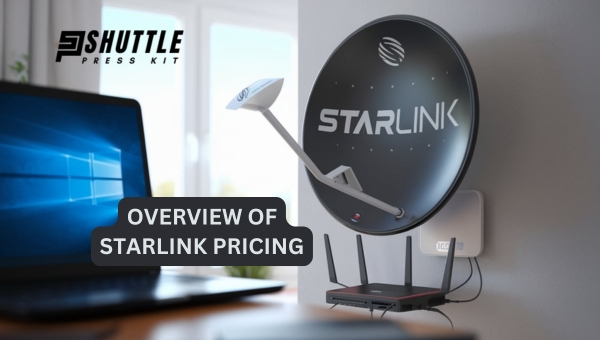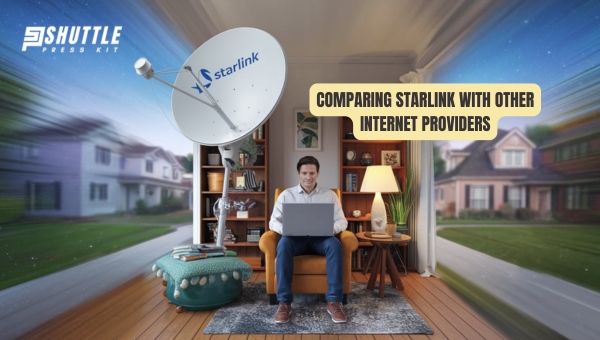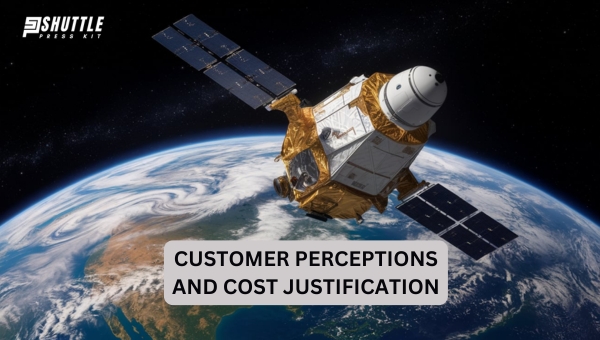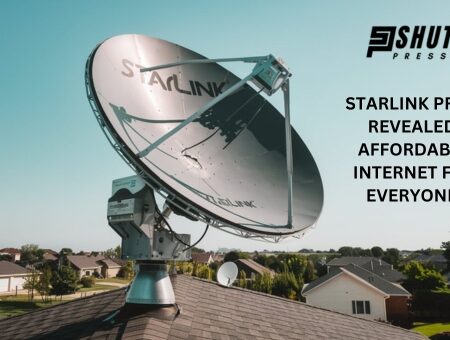Curious about Starlink price and what it means for you? Look no further. In this article, we’ll dive into the costs associated with Starlink, from monthly plans to equipment fees.
We’ll also explore how factors like location and data usage can impact your bill. Plus, we’ll compare Starlink to other internet providers and share insights from real users.
Whether you’re in a remote area or just looking for top-notch internet, we’ve got you covered. Let’s get started! Here’s the table rewritten in text format:
| Plan | Price | Equipment fee | Download Speed | Latency |
|---|---|---|---|---|
| Starlink Standard | $120.00/mo. | $499.00 | 20–100Mbps | 25–60ms |
| Starlink Priority | $140.00–$500.00/mo. | $499.00–$2,500.00 | 40–220Mbps | 25–60ms |
| Starlink Mobile | $150.00–$250.00/mo. | $499.00 | 5–50Mbps | <90ms |
| Starlink Mobile Priority | $250.00–$5,000.00/mo. | $2,500.00 | 40–220Mbps | <90ms |
Overview
Starlink offers diverse pricing options to cater to various user needs, especially in rural and underserved areas. The standard plan, priced at around $120 per month, provides speeds ranging from 25 to 100 Mbps. This makes it a solid choice for those looking for reliable internet access in regions where traditional services might fall short.

Additionally, there’s a one-time equipment fee of $599. For users seeking enhanced performance, the Priority plan offers speeds between 40 and 220 Mbps, with costs ranging from $140 to $1,500 per month.
It’s noteworthy that this plan comes with higher equipment costs of up to $2,500. Starlink also presents a mobile plan at $150 per month, ideal for users on the go. The Mobile Priority plan, ranging from $250 to $5,000 per month, caters to more demanding mobile internet needs.
All plans feature unlimited data, making Starlink a viable choice despite its higher price point compared to traditional services.
Also Read: How Fast Is Starlink Internet? Discover The Speed Results!
Subscription Costs
When considering Starlink as your internet provider, understanding the associated subscription costs is crucial. These costs are divided into monthly plans and one-time fees, each designed to meet different user needs. Let’s explore what you can expect to pay for Starlink’s services.
Monthly Plans
Starlink offers several monthly subscription plans to cater to different user requirements. Here are the primary options:
- Standard Plan: $110 per month, suitable for most households.
- Business Plan: $500 per month, designed for higher data needs and faster speeds.
- Rural Plan: $90 per month, available in select areas for those living in more remote locations.
Each plan includes internet access with varying speeds and data allowances, depending on the specific plan chosen.
One-Time Fees
In addition to the monthly subscription costs, there are several one-time fees associated with subscribing to Starlink. These fees cover the initial setup and equipment needed to get started:
- Equipment Fee: $549 for the Starlink Kit, which includes a satellite dish and router.
- Shipping Fee: Approximately $50 for delivering the equipment.
- Installation Fee: Typically around $100, depending on whether professional installation is required.
These one-time fees contribute to the initial costs of setting up Starlink services and are important to consider when planning your budget.
Also Read: Starlink Order Or Subscription: Quick Cancellation Guide
Equipment Costs
Navigating the realm of Starlink, it’s essential to delve into the costs associated with the necessary equipment. Understanding these costs will help you make informed decisions and ensure you have everything you need for a seamless internet experience.
Standard Kit
The Standard Kit is the basic equipment you’ll need to get started with Starlink. This kit includes:
- Dish antenna: This is the core of your Starlink setup. It connects to the satellites in orbit to provide you with internet service.
- Wi-Fi router: This router distributes the internet connection throughout your home.
- Cables and power supply: These components are necessary to connect your dish and router, ensuring everything works smoothly.
This kit is priced at approximately $499. It’s a one-time fee that covers all the essentials you need to embark on your Starlink journey.
Advanced Accessory Kits
For those looking to enhance their Starlink experience, there are Advanced Accessory Kits available. These kits offer additional features and improved performance. Some options include:
- High-performance mounts: These mounts provide better stability for your dish antenna, which can be crucial in areas with extreme weather conditions.
- Ethernet adapters: These adapters are useful if you prefer a wired connection for lower latency and higher reliability.
- Additional routers or mesh systems: If you have a larger home or multiple floors, these can help extend your Wi-Fi coverage.
The costs for these advanced kits can vary but typically range from $50 to $200 depending on the specific accessories you choose. These kits are optional but can significantly improve your overall experience with Starlink.
By understanding the costs and benefits of both the Standard Kit and Advanced Accessory Kits, you can better assess what fits your needs and budget.
Also Read:
Factors Affecting Starlink Price
Understanding the factors that influence the Starlink price can help you make a more informed decision. Several elements play a role in determining the cost, including location, customization options, and data usage.
Let’s break these down to see how each factor impacts the overall price.
Location and Availability
The price of Starlink services can vary significantly depending on where you live. In urban areas with ample internet options, the cost might be lower. However, in remote or underserved areas, the price could be higher due to the demand for reliable internet access.
- Urban Areas: Often benefit from competitive pricing due to multiple service providers.
- Rural Areas: May face higher costs as Starlink provides a vital service where other options are scarce.
- Global Availability: Depending on the country, regulatory fees and import duties can also affect the price.
Plan Customization
Starlink offers various plans that can be tailored to meet individual needs, impacting the overall cost. Customization options allow users to select features that best suit their requirements, affecting the final price.
- Basic Plans: Generally more affordable but come with standard features.
- Premium Plans: Include additional benefits like higher speeds and more data, which can increase the cost.
- Add-Ons: Optional services such as enhanced customer support or additional equipment can also raise the price.
Data Usage
Your data usage plays a crucial role in determining the price you pay for Starlink services. Different pricing tiers are available based on how much data you consume, and exceeding data limits can result in additional charges.
- Basic Data Plans: Suitable for light users who browse the internet and use social media.
- High Data Plans: Ideal for heavy users who stream videos and download large files.
- Overage Charges: Exceeding your data allowance can lead to extra fees, so it’s essential to choose a plan that matches your usage.
Understanding these factors can help you better navigate the pricing structure of Starlink services. By considering location, customization, and data usage, you can select a plan that meets your needs and budget.
Also Read: Satellite Internet: High-Speed Connectivity from Space
Comparing Starlink with Other Internet Providers
When comparing Starlink with other internet providers, several factors come into play. Each option has its unique strengths and weaknesses.

Speed:
- Starlink offers download speeds of up to 300 Mbps, with typical user speeds ranging from 60-90 Mbps.
- Traditional ISPs, especially those with fiber connections, can provide much higher speeds, reaching up to 5 Gbps in some areas. However, many users may only access speeds between 25-100 Mbps, depending on their location and available infrastructure.
Latency:
- Starlink’s latency is around 40-50 milliseconds, which is lower than traditional satellite services but higher than most ISPs.
- Most ISPs have latency typically ranging from 8-26 milliseconds, making them preferable for latency-sensitive applications like online gaming.
Reliability:
- Starlink is generally reliable, but its service can be affected by weather conditions.
- ISPs, particularly those using underground cables, tend to have fewer outages but can still experience disruptions during severe weather events.
Availability:
- Starlink has a distinct advantage in availability, providing service in rural and underserved areas globally.
- ISPs often have limited coverage, especially in remote locations, making Starlink a more viable option for those without traditional internet access.
Cost:
- Starlink’s pricing includes an upfront hardware cost and a monthly subscription fee, which can be higher than some ISP plans.
- For users in remote areas, the value of access may outweigh the costs compared to local ISPs.
By considering these factors, users can make a more informed choice about which internet service best meets their needs.
Also Read: OneWeb vs. Starlink: A Dive into Satellite Internet Provider
Customer Perceptions and Cost Justification
When it comes to gauging customer perceptions and justifying the cost of Starlink services, there are several key areas to consider. The value provided, especially in remote regions, and user experience insights play a significant role.

Value for Remote Areas
Many customers in remote areas view Starlink as a game-changer. Traditional internet services are often unreliable or unavailable in these regions. Starlink offers a viable alternative, providing high-speed internet where it was previously scarce.
- Accessibility: One of the primary benefits is accessibility. Starlink reaches locations that other providers cannot, making it a preferred choice for many in secluded areas.
- Reliability: Users report fewer outages and consistent service, which is a dramatic improvement over existing options.
- Speed: The high-speed connectivity offered by Starlink is often unmatched in these areas, allowing users to stream, work, and communicate more effectively.
User Experience Insights
Understanding the user experience is crucial for justifying the cost of Starlink. Feedback from users indicates that while the initial investment may be high, the benefits often outweigh the expenses.
- Ease of Installation: Users find the installation process straightforward, with clear instructions and minimal technical difficulties.
- Performance: The overall performance is highly rated, with users experiencing faster download and upload speeds compared to their previous providers.
- Cost Efficiency: Despite the higher initial cost, many users feel that the long-term benefits, such as reliable service and high-speed internet, make the investment worthwhile.
- Customer Support: Positive reviews often highlight the responsive customer support, helping users troubleshoot and resolve issues quickly.
By focusing on these aspects, it’s evident that Starlink’s pricing can be justified through its unique offerings and user satisfaction, particularly in underserved areas.
Conclusion
Starlink price landscape can seem complex, but understanding the key elements makes it easier. From subscription costs to equipment fees, each aspect plays a crucial role in the overall cost.
Additionally, factors like location and data usage significantly impact pricing. Comparing Starlink with other internet providers highlights its unique value, especially in remote areas.
Customer perceptions and experiences further justify the cost, making Starlink a viable option for many.
Eager to learn more about tech and internet services? Dive into our other insightful blogs for more information!
